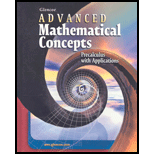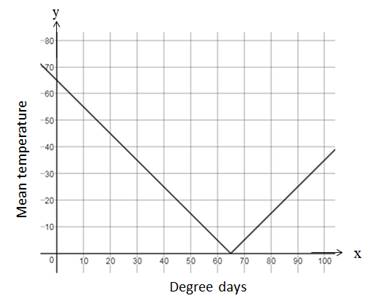
Concept explainers
a.
To find: the type of function represented the degree days.
a.
Answer to Problem 28E
Absolute value function
Explanation of Solution
Given information:
The number of degree days =
Mean temperature =
Number of degree days is the difference between 65 and the mean temperature.
If
If
Calculation:
Since the table shows different linear rates, the function of degree days due to mean temperature should be a absolute value function.
Thus, the type of function for the given situation is absolute value function.
b.
To find: the function to model
b.
Answer to Problem 28E
Explanation of Solution
Given information:
The number of degree days =
Mean temperature =
Number of degree days is the difference between 65 and the mean temperature.
If
If
Calculation:
Since the number of degree days is the difference between 65 and the mean temperature. The function of
c.
To graph: the function.
c.
Answer to Problem 28E

Explanation of Solution
Given information:
The number of degree days =
Mean temperature =
Number of degree days is the difference between 65 and the mean temperature.
If
If
Calculation:
The table of values given is as follows:
| 25 | 40 |
| 35 | 30 |
| 45 | 20 |
| 55 | 10 |
| 65 | 0 |
| 75 | 10 |
| 85 | 20 |
| 95 | 30 |
The graph for the above function is as follows:

d.
To find:
d.
Answer to Problem 28E
Heating days
Explanation of Solution
Given information:
The number of degree days =
Mean temperature =
Number of degree days is the difference between 65 and the mean temperature.
If
If
High temperature =
Low temperature =
Calculation:
Substitute the value of high temperature in the function to evaluate
Thus,
Substitute the value of low temperature in the function to evaluate
Thus,
Since
Chapter 1 Solutions
Advanced Mathematical Concepts: Precalculus with Applications, Student Edition
Additional Math Textbook Solutions
Calculus: Early Transcendentals (3rd Edition)
Precalculus
Single Variable Calculus: Early Transcendentals (2nd Edition) - Standalone book
Calculus and Its Applications (11th Edition)
Calculus: Early Transcendentals (2nd Edition)
 Calculus: Early TranscendentalsCalculusISBN:9781285741550Author:James StewartPublisher:Cengage Learning
Calculus: Early TranscendentalsCalculusISBN:9781285741550Author:James StewartPublisher:Cengage Learning Thomas' Calculus (14th Edition)CalculusISBN:9780134438986Author:Joel R. Hass, Christopher E. Heil, Maurice D. WeirPublisher:PEARSON
Thomas' Calculus (14th Edition)CalculusISBN:9780134438986Author:Joel R. Hass, Christopher E. Heil, Maurice D. WeirPublisher:PEARSON Calculus: Early Transcendentals (3rd Edition)CalculusISBN:9780134763644Author:William L. Briggs, Lyle Cochran, Bernard Gillett, Eric SchulzPublisher:PEARSON
Calculus: Early Transcendentals (3rd Edition)CalculusISBN:9780134763644Author:William L. Briggs, Lyle Cochran, Bernard Gillett, Eric SchulzPublisher:PEARSON Calculus: Early TranscendentalsCalculusISBN:9781319050740Author:Jon Rogawski, Colin Adams, Robert FranzosaPublisher:W. H. Freeman
Calculus: Early TranscendentalsCalculusISBN:9781319050740Author:Jon Rogawski, Colin Adams, Robert FranzosaPublisher:W. H. Freeman
 Calculus: Early Transcendental FunctionsCalculusISBN:9781337552516Author:Ron Larson, Bruce H. EdwardsPublisher:Cengage Learning
Calculus: Early Transcendental FunctionsCalculusISBN:9781337552516Author:Ron Larson, Bruce H. EdwardsPublisher:Cengage Learning





